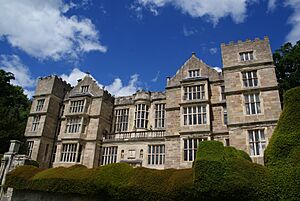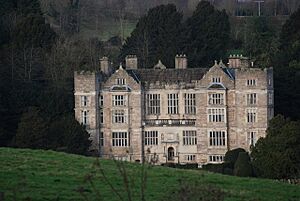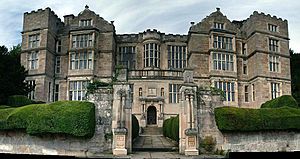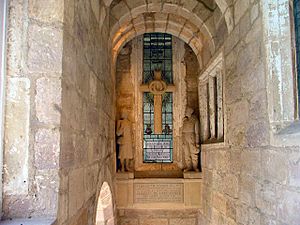Fountains Hall facts for kids
Quick facts for kids Fountains Hall |
|
|---|---|

Fountains Hall
|
|
| Type | Prodigy house |
| Location | Studley Royal Park |
| Built | 1598-1611 |
| Built for | Sir Stephen Proctor |
| Architectural style(s) | Elizabethan and Jacobean |
| Owner | National Trust |
|
Listed Building – Grade I
|
|
| Official name: Fountains Hall | |
| Designated | 23 April 1952 |
| Reference no. | 1149809 |
| Lua error in Module:Location_map at line 420: attempt to index field 'wikibase' (a nil value). | |
Fountains Hall is a beautiful country house located near Ripon in North Yorkshire, England. It is part of the amazing Studley Royal Park, which is a World Heritage Site. This special site also includes the ancient ruins of Fountains Abbey. Today, Fountains Hall is owned by the National Trust and is considered a very important historic building.
Contents
The Story of Fountains Hall
Building a Grand House
Fountains Hall was built by a man named Stephen Proctor. Construction started in 1598 and finished in 1611. Interestingly, some of the stone used to build the house came from the nearby ruins of Fountains Abbey.
The house is a great example of a "prodigy house" from the late Elizabethan era. These were large, impressive homes built to show off wealth and power.
Early Visitors and Owners
In July 1604, Prince Charles (who later became King Charles I) visited Fountains Hall. He was traveling to London from Dunfermline Palace. Stephen Proctor mentioned that a neighbor, Sir John Yorke, caused some trouble during the visit because he was arguing with Proctor.
After Stephen Proctor passed away in 1619, Fountains Hall was taken over by the Messenger family. About 150 years later, they sold it to William Aislabie, who owned the nearby Studley Royal estate. Since the Aislabie family already lived at Studley Royal, Fountains Hall was often rented out to other people. At one point, parts of it were even used to store farm supplies!
Modern Times and Renovations
Between 1928 and 1931, Fountains Hall was carefully updated and modernized. The Duke and Duchess of York, who later became King George VI and Queen Elizabeth, often stayed there. They were guests of Lady Doris Vyner.
During the Second World War, Fountains Hall became a safe place for people who had to leave their homes. It was used to house evacuees. Queen Ethelburga's School from Harrogate moved its sanatorium (a place for sick students) to Fountains Hall. The stable area was turned into dormitories for students, and a corner became the school chapel.
The hall has a balcony, but visitors cannot use it because the staircase is not safe for public use.
A Special Memorial
The Vyner family, who lived at Fountains Hall, sadly lost two of their children during the Second World War. Their son, Charles, was a pilot in the Royal Naval Reserve and went missing in action near Rangoon. Their daughter, Elizabeth, was in the Women's Royal Naval Service and passed away while serving in Felixstowe.
There is a beautiful sculpture at Fountains Hall that remembers them. You can see it when you walk down the stone steps from the house. The words on the memorial begin with a famous quote by John Maxwell Edmonds:
WHEN YOU GO HOME
TELL THEM OF US
AND SAY
FOR YOUR TOMORROW
WE GAVE OUR TODAY
FROM THIS THEIR HOME, THEY WENT FORTH TO WAR.
Elizabeth Vyner WRNS – Died on Active Service June 3rd 1942 Aged 18 years.
Also her brother Charles De Grey Vyner Sub Lieut (A) RNVR Reported missing
from Air Operations Off Rangoon May 2nd 1945 Aged 19 Years.
After the war, the hall became run down again. However, the National Trust took over the Fountains Estate in 1983. They have worked hard to restore the hall. Part of the building has been turned into apartments, and one of them can even be rented for holidays. Visitors to Fountains Abbey can explore the oak-paneled stone hall and a special exhibition room. There are also plans to restore the chapel.
Fountains Hall on Screen
Fountains Hall has been used as a filming location for movies and TV shows!
- In 2017, the outdoor scenes for the first episode of the BBC One miniseries Gunpowder were filmed here. This show was about the events leading up to the Gunpowder Plot.
- Some outdoor scenes for the 1993 film The Secret Garden were also filmed at Fountains Hall.
See also
- Grade I listed buildings in North Yorkshire (district)
- Listed buildings in Lindrick with Studley Royal and Fountains





